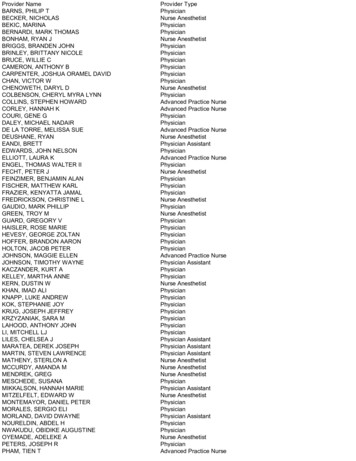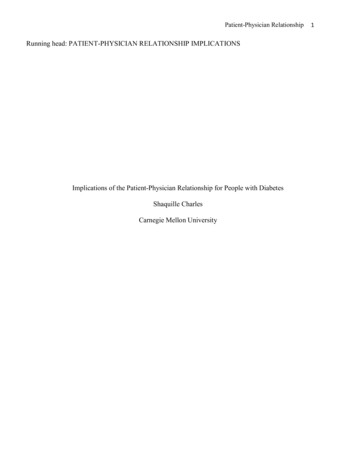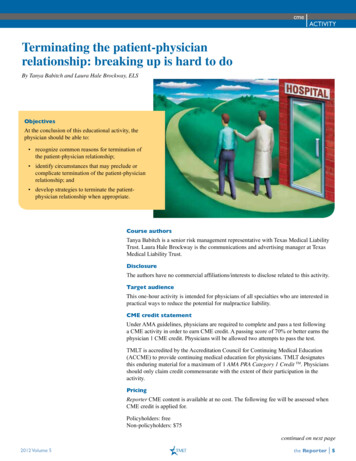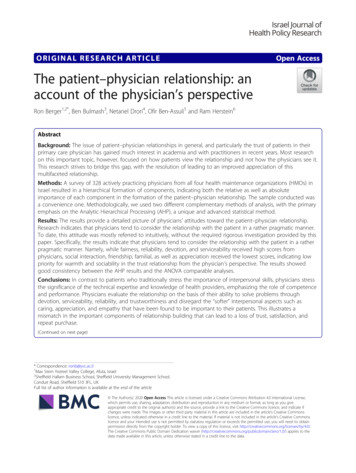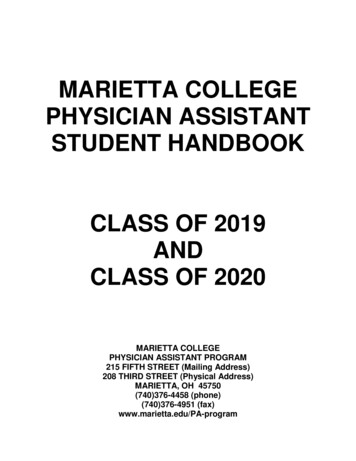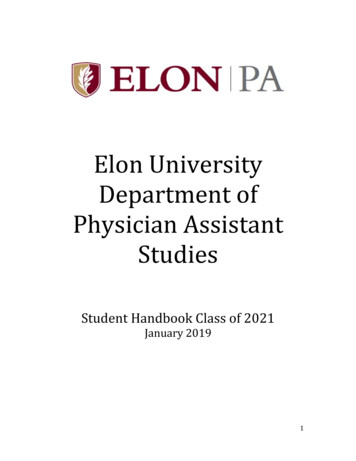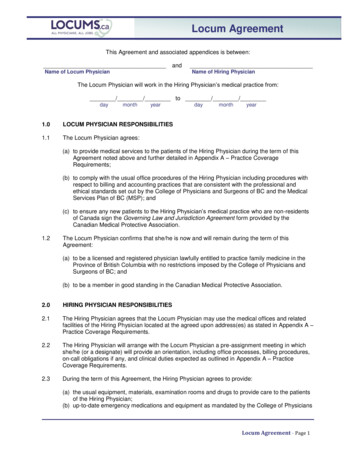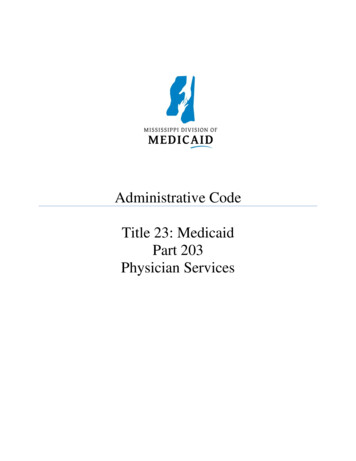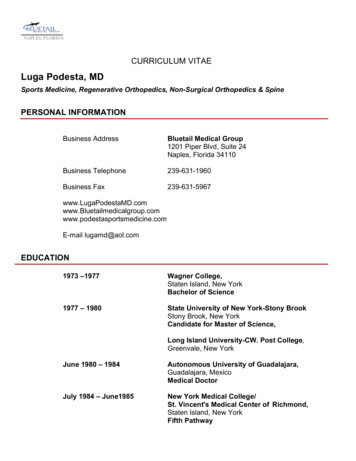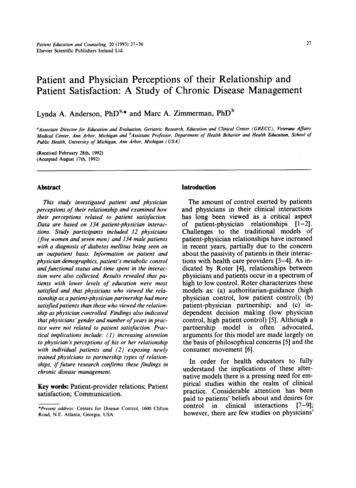
Transcription
21Patient Education and Counseling, 20 (1993) 21-36Elsevier Scientific Publishers Ireland Ltd.Patient and Physician Perceptions of their Relationship andPatient Satisfaction: A Study of Chronic Disease ManagementLynda A. Anderson,PhDap* and Marc A. Zimmerman,PhDbaAssociate Director for Education and Evahution, Geriatric Research, Education and Clinical Center (GRECC).Veterans AffairsMedical Center, Ann Arbor, Michigan and bAssistant Professor, Department of Health Behavior and Health Education, School ofPublic Health, University of Michigan, Ann Arbor, Michigan (USA)(Received February 28th, 1992)(Accepted August 17th, 1992)AbstractIntroductionThis study investigated patient and physicianperceptions of their relationship and examined howtheir perceptions related to patient satisfaction.Data are based on 134 patient-physician interactions. Study participants included 12 physicians(five women and seven men) and 134 male patientswith a diagnosis of diabetes mellitus being seen onan outpatient basis. Information on patient andphysician demographics, patient’s metabolic controland functional status and time spent in the interaction were also collected. Results revealed that patients with lower levels of education were mostsatisfied and that physicians who viewed the relationship as a patient-physician partnership had moresatisfiedpatients than those who viewed the relationship as physician controlled. Findings also indicatedthat physicians’gender and number of years in practice were not related to patient satisfaction. Practical implications include: (1) increasing attentionto physician S perceptions of his or her relationshipwith individual patients and (2) exposing newlytrained physicians to partnership types of relationships, if future research confirms these findings inchronic disease management.The amount of control exerted by patientsand physicians in their clinical interactionshas long been viewed as a critical aspectof patient-physicianrelationships[l-2].Challenges to the traditional models ofpatient-physician relationships have increasedin recent years, partially due to the concernabout the passivity of patients in their interactions with health care providers [3-41. As indicated by Roter [4], relationships betweenphysicians and patients occur in a spectrum ofhigh to low control. Roter characterizes thesemodels as: (a) authoritarian-guidance(highphysician control, low patient control); (b)patient-physicianpartnership; and (c) independent decision making (low physiciancontrol, high patient control) [5]. Although apartnershipmodel is often advocated,arguments for this model are made largely onthe basis of philosophical concerns [5] and theconsumer movement [6].Key words: Patient-provider relations; Patientsatisfaction; Communication.*Present address: Centers for Disease Control, 1600 CliftonRoad, N.E. Atlanta, Georgia, USAIn order for health educators to fullyunderstand the implications of these alternative models there is a pressing need for empirical studies within the realm of clinicalpractice. Considerable attention has beenpaid to patients’ beliefs about and desires forcontrolin clinical interactions[7-91;however, there are few studies on physicians’
28perceptions of their relationship with patients.Even more striking is the dearth of information on both physicians’ and patients’ perceptions of their relationship. A clearerunderstandingof how perceptions aboutpatient-physician relationships relate to patients’ outcomes will assist health educators todevelop more effective programs orientedtoward enhancing care. This understandingmay also help providers in establishing moresatisfying relationships with patients. Asdocumented in numerous studies, patientsatisfaction is an important component ofquality of care because it is linked tonumerous other patient outcomes, such asadherence to the prescribed therapy, droppingout of care and malpractice litigation [lo].The purpose of this paper is to expand thedeveloping literature on models of thepatient-physician relationships by documenting physicians’ and patients’ perceptions oftheir relationship and their impact on patientsatisfaction. For the purposes of this study,patient-physician relationships are examinedwithin the context of chronic disease management. Chronic disease management is a particularly fruitful area of inquiry because it hasbeen identified as one that is highly suited toa management approach based on a partnership model of care [ 111. Two major researchquestions are addressed. First, do demographic and treatment factors, patients’perceptions of the relationship and/or physicians’ perceptions of the relationship relate topatient satisfaction? Second, to what extentare physicians’ perceptions of the relationshipin agreement with patients’ perceptions of therelationship? Additionally, exploratory analyses are conducted with factors that mayassist in understanding patients’ and physicians’ perceptions of their relationships.Veterans Affairs Medical Center (VAMC)and the General Medicine Clinics of theDurham VAMC. Patients in these clinics wereassigned to a specific physician and were seenby that physician on all subsequent visits.Eligibility criteria included patients with aconfirmed diagnosis of diabetes mellitus beingtreated with oral agents or insulin therapy.Patients had been seen on at least one priorUnder theoccasion by the physician.authorization of the human studies committees, eligible persons were identified primarilythroughpharmacyand medical recordreviews. Patients were asked to participateduring routine outpatient appointments. Datawere collected from all eligible patients withineach physician’s clinic over a period of 12months in 1989-1990. A maximum of 15 patients were obtained from each physician’sclinic.Audiotape recordings were obtained with aportable tape recorder with a Pressure ZoneMicrophone@ that was placed as unobtrusively as possible in the examining rooms prior tothe study visit. All parties had previously provided informed consent for this procedure.After the clinic visit, research personnel collected the audiotape and the physician wasasked to complete an individual patient questionnaire. This questionnaire was designed togather information on the physician’s perceptions of the relationship with that individualpatient and to assess the patient’s functionalstatus and diabetes metabolic control status.All consenting patients participated in afollow-up telephone interview, which wasconducted within 3 days of the clinic visit. Theinterview collected data on demographic andtreatment variables, assessed patient’s perception of the relationship and determinedhis/her satisfaction with care.MethodsStudy setting and designData reported here are based on a sampleof 134 physician-patient interactions. Participants were recruited from two sources: theAmbulatory Care Clinics of the Ann ArborCharacteristics of the respondentsPatient participants. A total of 166 patientswith a confirmed diagnosis of diabetesmellitus were asked to participate in thisstudy. A total of 27 patient-physician encounters were excluded from these analyses.
29Only 7 patients refused to participate. Additionally, in 20 cases, either the patient couldnot be contacted during a 3-day follow-upperiod (n 10) or the audiotape recordingwas later determined to be incomplete (n 10;in four cases the interview was inadvertentlynot taped and in six cases the doctor turnedthe tape off when he/she left the room andforgot to turn it back on). Additionally, fivewomen agreed to participate but were not included in this analysis because of their smallnumber. Thus, the final study sample consistsof 134 male patients with complete encounterdata.The mean age of patient participants was64.3 years (S.D. f 7.91 years). All participants were prescribed medications fortheir diabetes, with 72 (54%) prescribed insulin, 58 (43”/) prescribed oral medicationsand 4 (3”/0 prescribed both insulin and oralmedications. Sixty participants (45%) had lessthan 11 years of formal education, 28 (21%)had graduated from high school, 44 (34%) hadsome college education or were collegegraduates and two provided no data. A totalof 89 (66%) were currently married, 14(10.5%) were widowed, 22 (16.5OY0)weredivorced or separated, and 9 (7%) were nevermarried. One-hundred six (79Oh)participantswere White, 24 (18%) were Black and 4 (3%)were from other ethnic groups. Participantsfrom the Ann Arbor VAMC included agreater proportionof patients who wereWhite compared to participants from theDurham VAMC; however, the two samplesdid not differ with respect to age, educationlevel, marital status, or fasting blood glucoselevels (i.e. metabolic control).Physician participants. A total of 13 physicians were invited to participate from bothsites. Physicians were invited to participate ifthey held regularly scheduled clinics duringthe study period and had a large number ofpotentially eligible subjects, who were identified by pharmacy record reviews over a 6month period. One physician’s clinic wassubsequently dropped because this was a newclinic involving only first time patient visits.The physician sample included seven menand five women. Number of years in practiceaveraged 3.2 years (S.D. f 3.7 years). Themean age of the sample was 30.8 years(SD. * 5.0 years). The number of patientsincluded in the study per physician clinicaveraged 11.3 (S.D. f 9.0).Comparisons of participants and nonparticipants. Based on data gathered from a ques-tionnaire given to all clinic physicians,physicians included in the study (n 12) didnot differ from other physicians in theseclinics (n 24) with respect to age, sex, yearsin practice, number of patients being seen, orbeliefs about treating patients with diabetesmellitus [12]. Additionally, participants didnot significantly differ from the 27 individualsexcluded from the analyses with respect toage, levels of education, ethnic group, ormarital status.MeasuresStudy physicians were asked to complete anindividual questionnaire for each patient whoconsented to participate in the study. A singleitem was used to assess physicians’ perceptions of the patient-physician role relationship. The item was pretested with a group ofphysicians prior to use in this study. It shouldbe noted that the item assessed the physician’sperception of the relationship with that individual patient and not patients in general.Response options were based on the three rolerelationships hypothesized by Roter [5] andestablished empirically in studies of patients’desires for control [8] and reflected: (a)authoritarian-guidance,herein referred to asphysician controlled; (b) patient-physicianpartnership; or (c) independentdecisionmaking (see item in note 1). In only three instances did the physician select independentdecision-making to characterize the relationship and these cases were reassigned to thepatient-physician partnership category. Thus,perception of the relationship was reduced totwo categories: (a) physician controlled and(b) patient-physicianpartnership.Patientfunctional status and diabetes metabolic con-
30trol, subsequently referred to as disease consequences, were each rated on a four-pointLikert scale (1 excellent to 4 poor). Functional status ratings ranged from 1 to 4, witha mean of 2.28 (S.D. f 0.89). Metabolic control ratings ranged from 1 to 4, with a meanof 2.56 (S.D. f 1.07)All consenting patients then participated ina follow-up telephone interview. However, ina few cases an in-person interview wasscheduled at the convenience of the patient. Asimilar item was used to assess the patient’sperceptions of the patient-physician role relationship (see note 1). It should be noted thatthe item assessed the patient’s perception ofthe relationship with that individual physicianand not physicians in general. The itemunderwent extensive pretesting prior to use inthis study. In only two instances did the patient select independent decision-making tocharacterize the relationship and these caseswere reassigned to the patient-physician partnership category. Therefore, perception of therelationshipwas also reduced to twocategories: (a) physician controlled and (b)patient-physician partnership. A nine-itemmeasure developed by McCaul, Glasgow andSchafer [ 131 was used to measure patients’satisfaction with the care provided by theirphysician during the clinic visit. The measureused a six-point Likert rating scale (1 verydissatisfied to 6 very satislied) and had aCronbach alpha of 0.80. Satisfaction scoresranged from 3.0 to 6.0 with a mean of 5.5(S.D. f 0.60).Total encounter time was determined fromthe audiotape recording, measuring the timefrom the first physician or patient utteranceuntil the last utterance. Complete interviewswere determined by the ending remarks andsalutations. The recorded clinical interactionbetween the physician and patient was timed(i.e. telephone calls unrelated to the patient’sclinic visit or other interruptions such as thephysician leaving the room were excludedfrom the encounter time). Interactions between physicians and patients lasted anaverage of 21.37 min (S.D. f 9.05 min).ResultsPatients’ and physicians’ perceptionsrelationshipof theThe question of whether physicians’ andpatients’ perceptions of the relationship arerelated to patient satisfaction was examinedby analyses conducted in three stages. First,the issue of the appropriate unit of analysiswas examined. Second, demographic andtreatment variables were tested for significance prior to regression analysis. Finally,regression analysis was conducted.Unit of analysis. Following the recommendationsof Whiting-O’Keefe[14] andPedhazur [ 151,an analysis was first conductedto determine the correct unit of analysis. Theissue of concern here was whether the appropriate unit of analysis is the physician’sclinic or the patient-physician encounter. Aregression equation was used where patientsatisfaction was regressed on: (1) physicians’perceptions of the patient-physician relationship, (2) physicians’ perceptionsof thepatient-physician relationship nested withineach physician’s clinic (i.e. physicians’ perceptions of the relationship averaged over all encounters within each physician’s clinic), and(3) physicians’ perceptions of the relationshipby patients’ perceptions of the relationship(i.e. an interaction term). The physician’sclinic would be the appropriate unit ofanalyses if the nested variable had a non-zeroeffect (i.e. statistically significant) for predicting satisfaction or if the nested variable interacted with the individualencountervariable. Conversely, if only the individual encounter variable was related to patientsatisfaction in the regression analysis then itwould be appropriate to use it as the unit ofanalysis.The F-test for physicians’ perceptions of therelationship and patient satisfaction wassignificant,F(1,132) 15.01, P I 0.0002.However, no significant effect was found forphysicians’ perceptionsof the patientphysician relationship nested within eachphysician’s clinic and patient satisfaction,
31F( 18, 113) 1.66, NS. Finally, the interactionterm, physicians’ perceptions of the relationship by patients’ perceptions of the relationship, was also not significant, F(2,131) 1.80,NS. These results provided support for theuse of the individual encounter as the appropriate unit of analysis.demographicandtreatmentPatientvariables. Following the recommendations ofCramer [16], predictor variables (i.e. patients’age, levels of education, race, fasting bloodsugar levels, disease consequences and physicians’ years in practice and sex) were firsttested for significance with patient satisfaction (P I 0.05). Levels of education of patients was the only variable that wassignificantly related to patient satisfaction,r -0.18, P I 0.04. Patients’ age, race, orfasting blood sugar levels were not related topatient satisfaction. Furthermore, no significant relationships were found for disease consequences and patient satisfaction. Finally,physicians’ years in practice and sex were notrelated to patient satisfaction.Regression analysis. The final regressionanalysis assessed the relationship of patients’levels of education, patients’ perceptions ofthe relationship and physicians’ perceptionsof the relationship and patient satisfaction.Table 1 reports the results of the stepwiseregression equation. The zero-order correlation of each predictor variable with patientsatisfaction,the final standardizedbetaweight and the RZ change for each step of theequation are reported.Patients’ levels of education had a significant non-zero weighting in the final regressionequation (see note 2). Patients’ perception ofthe relationship did not contribute a signiticant amount of the variance. Physicians’perceptions of control, however, contributedthe most variance for predicting patientsatisfaction, with physicians who characterized the patient-physicianrelationship as apartnership having patients who expressedhigher levels of satisfaction. The regressionequation included two interaction terms,Table 1. Zero-order correlations and multipleregression results for patient satisfaction.PredictorsPatients’ levels ofeducationPatients’ perceptionof the relationshipPhysicians’ perceptionof the relationshipPatient’s education xPhysicians’ perceptionPatient’s education xPatients’ perceptionrFinalBetaStep *0.00-0.450.01-0.570.01-0.09Note: The final beta listed is the standardized beta whenall variables were entered in the equation. Higher scoresfor physicians’ and patients’ rating of the relationshiprefer to a patient-physician partnership.*P 5 0.05. **p 5 0.01education level by patient relationship ratingsand education level by physician relationshipratings, but these interaction terms did not explain any more variance. The multiple correlation for the final equation was 0.41 andthe R2 for the final equation was 0.17. Giventhat patient satisfaction scores were positivelyskewed, a regression analysis was conductedusing a log transformation in place of theoriginal data. The results of this regressionanalysis were virtually identical to the resultsreported previously.Similarity of physician’s and patient’s perception of the relationshipThe second question concerned the extentto which patients’ and physicians’ perceptionsof relationship are in agreement. Sixty percentof the physician-patientpairs (n 80)characterized the relationship along the samedimension. In 23% of the encounters (n 31)patients rated the interaction as a partnershipwhereas physicians rated the interaction asphysician controlled. Finally, in 17% of thephysician-patient encounters (n 22), physicians characterized the relationship as a part-
nership whereas patients characterized theinteraction as physician controlled. One casewas dropped because of missing values.Cohen’s kappa statistic (K)was then used todetermine physician-patient agreement oncechance agreement is removed [ 171. Values ofKrange from 1.O(complete agreement) to - 1.O(complete disagreement), with a score of 0 indicating agreement expected by chance alone(virtually no agreement). Physician-patientagreement regarding perceptions of control inthe interaction was K 0.05, S.E. 0.10, indicating agreement no better than expected bychance. Furthermore, patient satisfaction didnot differ between patient-physicianpairswho agreed about the nature of the relationship and those who disagreed about the relationship, t(131) -0.28, NS.Exploratory analysisGiven that little data exist regarding whatfactors may influence perceptions of the relationship, exploratory analyses were conducted examining the amount of time spentduring the clinic visit as well as variousdemographic factors and perceptions aboutthe relationship. These analyses involved performing multiple statistical tests, therefore, weused the Bonferroni adjustment to adjust theoverall acceptable significance level accordingto the number of comparisons being performed (See reference 18 for a discussion of interpreting multiple statistical tests). As a result,the alpha for each comparison was set atP I 0.003 (i.e. 0.05/16).Physicians’perceptions of the relationship. Asignificant difference was found regarding theamount of time spent during the clinic visitand physicians’ perceptions of the relationship, t(132) -4.06, P I 0.0001. Physicianswho characterized the relationship as a partnership were found to spend significantlylonger periods of time in the encounter (M 23.07 min) than physicians who characterizedthe relationshipas physician controlledM 17.08 mm). However, it should be notedthat the length of time spent in the clinic visitwas not significantly related to patientsatisfaction (r -0.05, NS). Additionally,physician years in practice was not related tothe time spent in the clinic visit (r -0.13,NS) nor did the amount of time spent in theclinic visit differ between women and menphysicians, t(132) 1.52, NS.Regarding the number of years in practice,a trend was found regarding differences inhow physicians’ perceived the relationship,t(132) -2.29, P 0.02. Physicians whocharacterized the relationship as a partnershiphad been in practice longer (M 4.18 years)than physicians who characterized the relationship as physician controlled (M 2.57years). As indicated previously, years in practice was not related to patient satisfaction.Patients ‘perceptions of the relationship. Nosignificant difference was found concerningthe amount of time spent in the clinic visit andpatients’ perceptions of the relationship,t(131) -0.58, NS. No significant differenceswere found for patients’ age, educational leveland race and patients’ perceptions of therelationship.Patient-physician agreement about the relationship. A trend was also found for physi-cians’ years in practice and patient-physicianagreement about the nature of the relationship, t(131) -2.15, P I 0.02. Physicianswho agreed with their patients about the relationship had been in practice longer (M 4.26) than physicians who disagree with theirpatients about the relationship (M 2.79).However, no significant difference was foundregarding the amount of time spent in theclinic visit and patient-physician agreementnor for physicians’ sex and patient-physicianagreement. A significant difference was foundregarding patients’ levels of education andpatient-physician agreement, x2(2, N 131) 17.18, P I 0.0001. Patients with the highestlevels of education were more likely to agreewith their physicians regarding the nature ofthe relationship (i.e. those with some collegeor college graduates) than patients with lowerlevels of education (i.e. high school graduates
33and lower levels of education). However, nosignificant differences were found regardingpatients’ age or race and patient-physicianagreement.cians who characterize the patient-physicianrelationship as a partnership have patientswho express higher levels of satisfaction thanphysicians who view the relationship as physician controlled (i.e. authoritarian guidance).Discussion and ConclusionsSeveral specific findings regarding the factors that relate to physicians’ perceptions ofthe relationship are noteworthy. First, physicians who view the relationship as a partnership are found to spend significantly longerperiods of time in the clinic visit than physicians who characterize the relationship asphysician controlled. Second, physicians whocharacterize the relationship as a partnershiphave been in practice longer than physicianswho characterize the relationship as physiciancontrolled. Time spent in the clinic visit andyears of practice are not related to patientsatisfaction. Thus, our findings suggest thatthe time spent with patients and physiciandemographic variables are related to perceptions of the relationship, but are not related tosubsequent patient satisfaction.Data from 134 patient and physician pairsconcerning their perceived role relationshipsprovide support for Roter’s theoretical conceptualizations of patient-physician relationships. Recall that Roter characterized thesemodels as: (a) authoritarian guidance (hereinreferred to as physician controlled), (b)patient-physicianpartnershipand (c) independent decision-making [5]. We foundthat patientsand physiciansgenerallycharacterize the relationshipalong twodimensions, either as patient-physician partnershiporphysiciancontrolled(i.e.authoritarian guidance). As expected, few patients or physicians actually characterize therelationship as one of independent decisionmaking. An earlier study investigating patients’ desires for control in clinical interactions found the same pattern of findings [8].From an applied perspective, the relativedearth of responses in which the relationshipis viewed as independent decision-making isnot surprising because the prospect of makingtherapeutic decisions without guidance orsupport may be seen as overwhelming to a patient [5]. As demonstrated in other studies ofpatients’ perceptionsof patient-physicianrelationships [6], our findings suggest that anauthoritarian-guidancemodel appears to nolonger dominate patient-physician relationships. In our sample of patients with diabetes,patients characterized 74% of the encountersas a partnership and physicians characterized67% of the encounters as a partnership.These findings also bear directly on Roter’sviews concerning the importance of a modelof patient-physician partnership. The resultsof our study demonstrate that physicians’perceptions of the relationship are associatedwith patient satisfaction. Specifically, physi-The only patient demographic variable thatrelates to patient satisfaction is patients’ levelsof education. Patients with higher levels ofeducation indicate lower levels of satisfaction.The negative relationship of patients’ levels ofeducation and patient satisfaction have beendocumented in other research studies [ 191.None of the patient demographic variablesoffer any clear insights into patients’ perceptions of the relationship. This is an area inneed of further study.We also tind the agreement betweenpatient-physicianpairs is no better thanchance. This finding is not surprising, giventhe lack of congruency in patient and physician views reported in prior research [20-211.Although patient-physician agreement is notrelated to patient satisfaction, this findingshould not be overstated because the majorityof patients and physicians expressed a partnership view of their relationship. An interesting finding related to patient-physicianagreement is that patients with at least somecollege education are more likely to agree
34with their physician about the nature of therelationship than are patients with lowereducation levels. The observed finding lendssupport to the tacit belief that when status differences are narrower the relationship is viewed more congruently then when greater statusdifferences exist. Future research shouldbenefit from explicitly examining those factors that may impact on patient-physicianagreement.Limitations of the present research shouldbe noted. Although the study includes over130 patient-physician pairs from two differentregions of the United States, the study involves a relatively small number of physicians,all of whom practice in the universityaffiliated VA Medical Center. It may be thatdifferent types of settings would yield different results. It is also quite possible that thefindings of this study might be different withother groups of patients, such as patients withan acute illness or women patients. Futureresearch needs to examine the generalizabilityand replicability of these findings. Second, thecross-sectional nature of the data cannot permit tests of causation. Thus, interpretation ofthe findings may be limited by the possibilityof halo effects and the inability to determinewhether physicians’ perceptions of the relationship lead to or are produced by patientsatisfactionin the interaction.Third,although we found a statistically significantdifference for years in practice, it may nothave clinical significance. Future studies needto attend to the issue of clinical significance.Finally, only selected characteristics of theclinical interaction and demographic factorsof patients and physicians were available forstudy. The amount of variance in patientsatisfaction accounted for by the variables included here is modest. Clearly, other factorsthat we did not examine may be operative.For example, the duration of the encounter,the number of encounters between the physician and patient, or the content of their communication may be significant factors thatinfluence patient gthen the confidence of our findings.First, this study is notable in that we includeboth patients’ and physicians’ perceptions ofinteractiongatherrelevanttheanddemographic and treatment data from bothparties. Second, care is taken to comparestudy participantsand non-participants,within both our physician and patientsamples. As a result, physicians involved inthe study do not differ from other physiciansin these clinics nor do patient participants differ from non-participants.Finally, we explicitly assess the issue of the appropriate unitof analysis. This issue has been virtually ignored in studies of patient-physician interactions (see Ref. 14 for a discussion of this issueto the field of patient-physician relationships).Practice implicationsThe findings from this study have severalimplications for practice. First, practitionersinterested in applying the knowledge we havegained from this study might profit by examining physician’s perceptions of the relationship with the individual patient. Second,if further research confirms the pattern of findings regarding physicians’ years in practice,training programs may want to direct more effort at newly trained physicians and aim atfacilitating their perceptions of more partnership types of
Patient Satisfaction: A Study of Chronic Disease Management Lynda A. Anderson, PhDap* and Marc A. Zimmerman, PhDb aAssociate Director for Education and Evahution, Geriatric Research, Education and Clinical Center (GRECC). . be noted that the item assessed physician's perception of relationship with that in- dividual patient and not patients .
